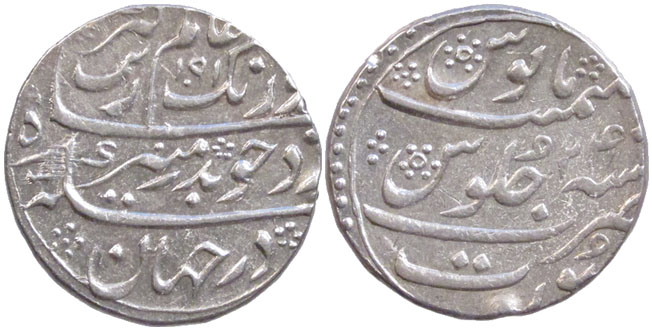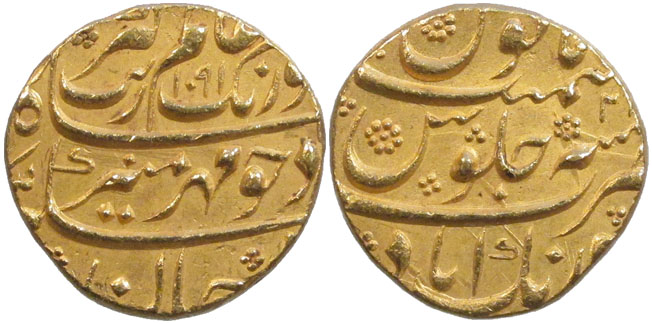| BrianRxm | Pirate Coins | 9/11 |
| Famous Pirates and Their Coins |
England's Henry Every and the Pirates of the Red Sea
| Prev | Back | Next |
The Pirates of the Red Sea, not as famous as the ones in the Caribbean, but in some ways more successful.
The "Red Sea" is also known as the "Arabian Sea."
A British pirate named Henry Every had a ship called the "Fancy" which patrolled the ocean between
Africa and India looking for merchant ships.
In 1695 he attacked a Mughal ship, the "Ganj Sawai" which meant something like "Ship full of treasure",
which was carrying wealthy Muslims back from the Mecca religious pilgrimage and Every got away with
several hundred thousand silver rupees and gold mohurs along with jewels and other loot.
The pirate crew behaved badly on the Mughal ship and when the Emperor Aurangzeb heard that the
pirates were British he had his soldiers arrest the British merchants in India.
Eventually a deal was worked out with the British paying Aurangzeb a large indemnity and beginning a
manhunt for Every's crew.
Some American colonial governors would protect pirates for a fee and many of Every's crew went to
America but had problems because the unusual money they had was "hot" and easy to recognize.
Some crew members were rounded up, taken to Britain, tried, and hung, but Every and his treasure
disappeared.
Mughal India Aurangzeb Silver Rupee:
This coin is a silver rupee of Mughal India minted around AD 1680 at Surat, a city in northwest India.
Surat was the largest and busiest port of the Mughal Empire and also the first port established
by the British East India Company in India.

1. Mughal silver rupee of Aurangzeb, Surat mint, AH 1091 (AD 1680)
Silver, 24 mm, 11.49 gm, Krause KM 300.86
The coin inscriptions are in Persian using Arabic letters.
Obverse:
Shah Aurangzeb Alamgir (Ruler, throne ornament, universe grasper)
Sikkah zad chu badr-e-monir (Coin struck like the full moon shining)
Dar Jahan (Throughout the World)
Reverse:
Maimanet Manus (Associated with prosperity)
Sanat 24 Julus (Year 24 of reign)
Zarb Surat (Struck at Surat)
Sikkah zad chu badr-e-monir (Coin struck like the full moon shining)
Dar Jahan (Throughout the World)
Sanat 24 Julus (Year 24 of reign)
Zarb Surat (Struck at Surat)
Aurangzeb:
Aurangzeb Alamgir, whose names meant in Persian "Ornament of the Throne and Conqueror of the World."
He lived from AD 1618 to 1707 or almost 90 year, and was emperor from AD 1658 to 1707.
He was the son of Shah Jahan (of the Taj Mahal fame) and managed to lock up his father and take
over the throne. He was sometimes known to the British as the "Grand Mogul."
Aurangzeb official accession date was the ninth month of the Islamic calendar, Ramadan 1 1068 or 1068-9-1
The coin's regnal year of 24 means that it was struck after 1091-9-1 or in the last three months of the year.
The British East India Company was founded in AD 1600 to engage in trade with the East Indies.
It opened a port at Surat in AD 1619 and began acquiring land in India for facilities.
The Mughal rulers of India sometimes had problems with the East India Company, they even had a war which
resulted in EOC officials apologing to the Emperor Aurangzeb.
When Aurangzeb came to the throne, Mughal coins had Islamic religious inscriptions on them such as
"There is no god but Allah" and "Muhammad is his messenger."
Aurangzeb was a devout Muslim and, worried that an infidel would step on the "Word of God"
laying on the ground, had the inscriptions removed and replaced by "Persian couplets",
simple slogans like "coin struck like shining full moon."
Aurangzeb was an absolute monarch. One wonders what would have happened if an American President
tried to remove "In God We Trust" from coins.
Mughal India Aurangzeb Gold Mohur:
This related coin also was minted in AH 1091 but at Aurangabad:

2. Mughal gold mohur of Aurangzeb, Aurangabad mint, AH 1091 (AD 1680)
Gold, 21 mm, 10.97 gm, Krause KM 315.11
The legends on this coin are the same as on the silver rupee except that this coin is "struck like shining sun"
instead of "struck like shining full moon."
Also only the first digit '2' of the regnal year is visible, the regnal year can be "23" or "24"
depending on when in AH 1091 it was struck.
Aurangabad is a city in western India and home of the famous Ajanta Buddhist cave monuments and the
Ellora Buddhist, Hindu and Jain monastery-temple caves.
Ceylon Treasure Hunt:
A large number of Surat rupees were found near Sri Lanka (Ceylon) in 1963 by underwater treasure hunters.
A trading ship belonging to the Emperor Aurangzeb sank around AD 1703 near the Great Basses reef
southeast of the island.
One of the group was the science-fiction author Arthur C. Clarke who lived in Sri Lanka at the time and
he wrote a book about the adventure entitled The Treasure of the Great Reef which was published in 1964.
| Prev | Back | Next |